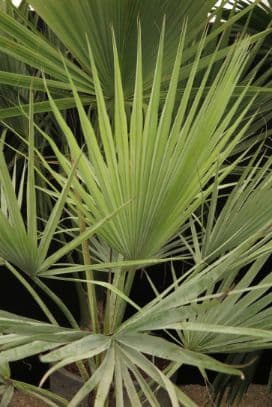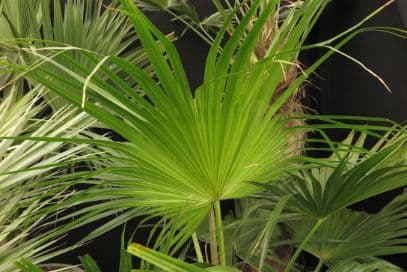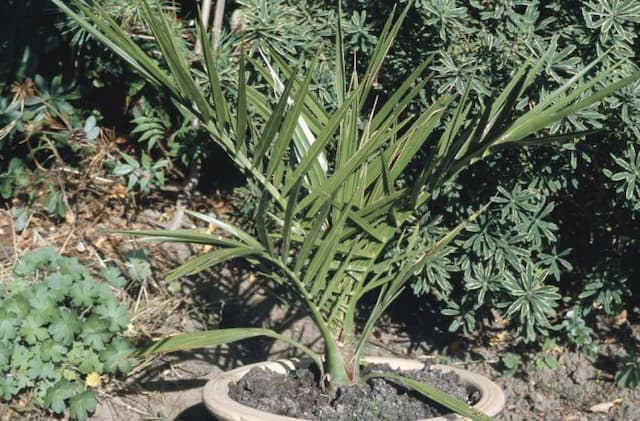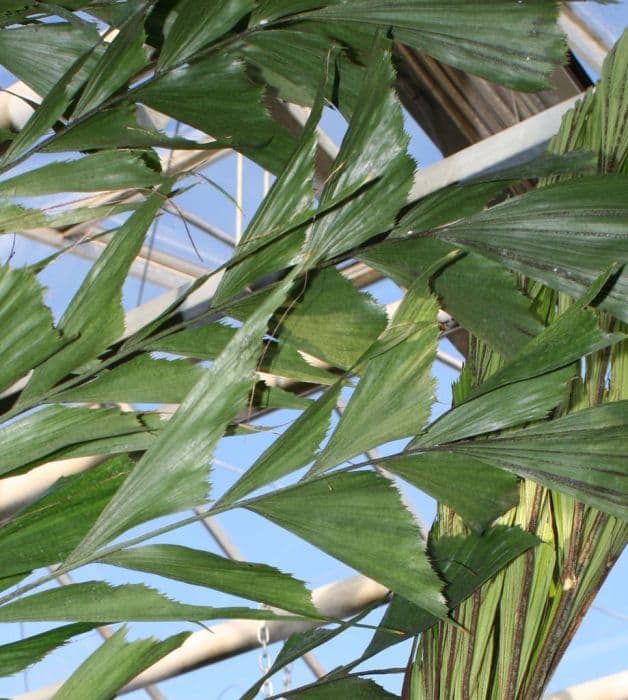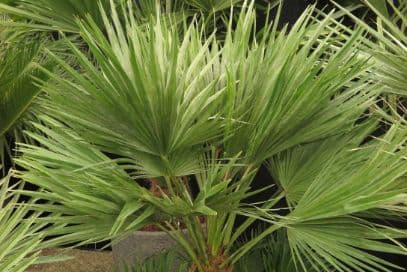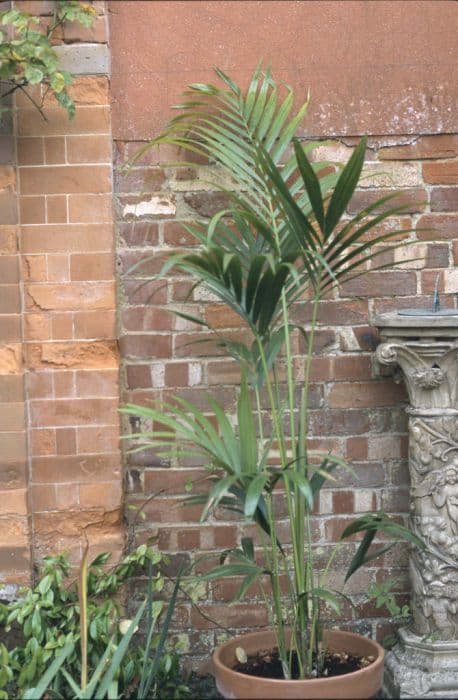Lady Palm Rhapis excelsa

ABOUT
The Rhapis excelsa, commonly known as the Lady Palm, is an elegant and versatile houseplant known for its fan-shaped foliage. The plant presents a lush appearance, with numerous dark green leaves divided into broad, ribbed segments. These leaves fan out gracefully from the central stalks, giving it a striking and attractive look. The segments contribute to the palm's overall aesthetic, creating a delicate and sculpted visual texture. The leaf stems are slender and may be covered with a fine, fibrous material, adding to the plant's intricate beauty. The Lady Palm develops multiple stems, which are actually the trunks that give it a bushy, dense form. The stems are erect and sturdy, giving the plant a robust and substantial presence. The leaves typically emerge from the top of these trunks, contributing to the plant's full and rounded canopy. The overall form of the Lady Palm makes it a favorite choice for interior decoration, providing an air of the tropics and serving as a natural air purifier.
About this plant
 Names
NamesSynonyms
Lady Palm, Broadleaf Lady Palm, Bamboo Palm.
Common names
Chamaerops excelsa, Rhapis flabelliformis, Trachycarpus excelsus.
 Toxicity
ToxicityTo humans
The Lady Palm is not poisonous to humans. It is generally considered safe and does not have toxins that cause harm when touched or ingested. Therefore, there are no symptoms of poisoning from the Lady Palm as it is not toxic.
To pets
The Lady Palm is not known to be toxic to pets either. It is widely regarded as a non-toxic plant to cats and dogs. Consequently, ingestion of this plant should not cause any symptoms of poisoning in pets. There are no adverse consequences typically associated with pets ingesting parts of the Lady Palm.
 Characteristics
CharacteristicsLife cycle
Perennials
Foliage type
Evergreen
Color of leaves
Green
Height
5-10 feet (1.5-3 meters)
Spread
3-5 feet (0.9-1.5 meters)
Plant type
Palm
Hardiness zones
9
Native area
Asia
Benefits
 General Benefits
General Benefits- Easy to care for – Rhapis excelsa, commonly known as the Lady Palm, is a hardy plant which can tolerate low-light conditions and infrequent watering.
- Adaptability – It can grow in various soil types as long as they’re well-draining.
- Indoor and outdoor versatility – The Lady Palm can be grown indoors as a potted plant or outdoors in suitable climates, adaptable to different environments.
- Longevity – It is a slow-growing plant that can live for many years with proper care.
- Non-toxic to pets – The plant is safe around pets as it is not known to be toxic to cats and dogs.
- Aesthetic appeal – With its fan-like fronds and upright growth habit, the Lady Palm adds a tropical and elegant touch to any space.
- Can be used for privacy screening – When planted in a row or cluster, Lady Palms can act as a natural privacy screen.
- Reduced noise levels – The dense foliage can help dampen noise, making it a good choice for creating a more serene environment.
- Low maintenance – It doesn't require frequent pruning, making it suitable for people who want a low-maintenance plant.
 Medical Properties
Medical PropertiesThis plant is not used for medical purposes.
 Air-purifying Qualities
Air-purifying QualitiesThis plant is not specifically known for air purifying qualities.
 Other Uses
Other Uses- Rhapis excelsa, commonly known as the Lady Palm, can be used as a natural privacy screen due to its dense foliage when planted closely together in a row.
- The trunk fibers of Lady Palms have been used in the past to create ropes and crafting materials in various cultures.
- The stiff leaves of the Lady Palm can be utilized in the creation of hats, fans, and mats with traditional weaving techniques.
- In bonsai culture, the Lady Palm can be trained into miniature forms, making it an attractive and unusual choice for tabletop bonsai displays.
- Lady Palm leaves can be spread on walkways to create a rustic and natural-looking pathway in gardens and landscaped areas.
- When dried, the fronds of the Lady Palm may be used as fodder for some types of livestock, though this is not a common practice.
- Due to its ability to tolerate low light, the Lady Palm is often used as a living prop in theater and film productions to simulate tropical settings.
- As a symbol of good fortune, Lady Palms are sometimes given as gifts in certain cultures during new year celebrations or as housewarming presents.
- The structural form of the Lady Palm is used in art and photography to provide an exotic or tropical element to compositions.
- In areas where the Lady Palm is native, the seeds may be used in traditional children's games or as components in handicrafts.
Interesting Facts
 Feng Shui
Feng ShuiThe Lady Palm can be utilized in Feng Shui as a means to enhance the energy in a space, being associated with the wood element. It can be placed in living areas or workplaces to promote the flow of positive Chi, purify the air, and bring a sense of calmness and well-being.
 Zodiac Sign Compitability
Zodiac Sign CompitabilityThe Lady Palm is not used in astrology practice.
 Plant Symbolism
Plant Symbolism- Elegance: The Rhapis excelsa, commonly known as the Lady Palm, has delicate, fan-shaped leaves that convey a sense of grace and sophistication.
- Privacy: Its dense foliage makes it an ideal choice for creating private spaces, symbolizing the human desire for seclusion and personal space.
- Purification: The Lady Palm is known for its air-purifying qualities, symbolizing cleanliness and the removal of negative energies from one's surroundings.
- Adaptability: This plant is adaptable to various light conditions, representing the ability to thrive in different environments and the virtue of flexibility.
- Longevity: With proper care, the Lady Palm can live for many years, making it a symbol of long life and enduring presence.
 Water
WaterThe Lady Palm should be watered when the top inch of soil feels dry, which typically means watering approximately once every 7-10 days. It's essential to maintain consistently moist soil, but avoid overwatering as this can lead to root rot. When watering, use around 16 to 32 ounces of water, ensuring even distribution across the soil surface. In the winter months, reduce watering slightly as the plant's growth slows down.
 Light
LightThe Lady Palm thrives in moderate, indirect light. It can also adapt to low-light conditions, making it an excellent indoor plant. The best spot for a Lady Palm would be near a window that receives filtered sunlight or in a well-lit room without direct exposure to harsh afternoon sun rays.
 Temperature
TemperatureThe Lady Palm prefers temperatures between 60 and 80 degrees Fahrenheit for ideal growth. It can withstand temporary dips down to about 50 degrees Fahrenheit but should not be exposed to temperatures below that as it may cause damage to the plant. Avoid placing the Lady Palm in areas with cold drafts or excessive heat from appliances.
 Pruning
PruningPrune the Lady Palm to remove yellow or brown fronds, as well as to shape the plant and manage its size. Pruning is best done in the spring or summer, and only occasional removal of old growth is necessary. Using clean, sharp scissors or pruning shears, cut the fronds at the base without damaging the main stalk.
 Cleaning
CleaningAs needed
 Soil
SoilThe Lady Palm prefers a well-draining soil mix, consisting of peat, sand, and loam. A pH between 5.5 and 6.5 is ideal for healthy growth. You can mix two parts peat, two parts pine bark, and one part coarse sand or perlite to create an optimal environment.
 Repotting
RepottingLady Palms should be repotted every couple of years as they outgrow their containers or as the soil becomes compacted. This typically happens when you can see the roots are crowding the pot or coming out of the drainage holes. Younger plants may need more frequent repotting.
 Humidity & Misting
Humidity & MistingLady Palms thrive best in moderate to high humidity levels, ideally between 40-60%. They can tolerate lower humidity environments but flourish when the air is more moist.
 Suitable locations
Suitable locationsIndoor
Provide bright, indirect light and keep away from drafts.
Outdoor
Shelter from direct sun, protect from cold and wind.
Hardiness zone
9-11 USDA
 Life cycle
Life cycleLady palm (Rhapis excelsa) starts its life as a seed, which germinates in warm, moist soil conditions, producing a sprout that develops into a seedling with characteristic palm-like leaves. The seedling stage sees the establishment of a strong root system and the development of a stout, fibrous stem that allows the seedling to grow into a juvenile palm. As the juvenile palm matures, it grows multiple stems, or 'canes', and becomes more resilient, eventually reaching its full height and spreading its large, fan-shaped leaves. The mature lady palm may produce flowers, typically small and inconspicuous, clustered on short inflorescences which, if successfully pollinated, can result in the production of small, fleshy fruits containing seeds. After many years, the lady palm can reach the end of its life cycle, with old canes dying back and newer growth taking over, continuing the cycle if the conditions allow seed dispersal and germination. Throughout its life, the lady palm will experience perennial growth, continually producing new leaves and shedding old ones as part of its natural growth rhythm.
 Propogation
PropogationPropogation time
Spring to early summer
The lady palm, or Rhapis excelsa, is commonly propagated by division, which is best done in late winter or early spring before new growth begins. To propagate by division, carefully remove the plant from its pot and gently separate the clumps of stems, making sure that each new section has its own roots. These divisions can then be potted in their own containers with well-draining potting mix, kept moist, and placed in indirect light until they establish themselves and start to show new growth. This method is favored for its simplicity and effectiveness in creating new plants that are true to the parent.
